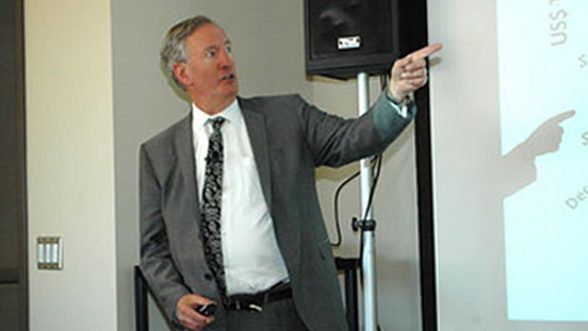
Bluford Putnam says Washington’s political climate ‘more bitter and divided’ than ever, making economic impacts more severe
The Federal Reserve’s massive asset purchase program has produced mixed short-term economic effects, while in the long term has weakened the Fed’s balance sheet, according to a leading national economist who spoke at the CU Denver Business School Oct. 3.
Bluford Putnam, Ph.D., chief economist for the CME Group, told a full classroom that quantitative easing (QE) succeeded in stabilizing volatile bond markets and lowering mortgage rates, but has done little to promote job growth and has mostly put a significant dent in long-term treasury note yields. Now, thanks to the political brinkmanship in Washington, D.C., over the budget and debt ceiling, the Fed’s QE exit plan is in limbo.
Putnam spoke as part of the Robert Reynolds Distinguished Lecture Series and the Institute for International Business. He was also interviewed on 9News about the market outlook during the government shutdown. The segment was filmed in the Business School’s J.P. Morgan Center for Commodities.
QE went into effect after the Great Recession of 2008-09. It has unfolded over five phases, Putnam explained, the most recent being an asset purchase program of $85 billion a month. The Fed is buying $40 billion a month in mortgage-backed securities and $45 billion a month in treasuries, a quarter of which (about $10 billion a month) are 10-year bonds or longer.
“The first round of QE essentially saved our financial system from a depression,” Putnam said. “But since then the biggest impact on treasury bond yields didn’t happen until they started buying the longer-term treasuries. When you start buying $10 billion of these a month, you’re going to have an impact on the longer-term treasury market.”
Initially, Fed Chairman Ben Bernanke said the exit would begin in September. But that plan changed due to Congressional gridlock and what has turned into a government shutdown and looming showdown on the debt ceiling. “The partisanship (in Washington) is more bitter and more divided than anything I’ve ever seen, far and away,” Putnam said.
Due to the rancor and uncertainty, Putnam said he has lowered his forecast of fourth-quarter GDP down from 2 percent to 0.5 percent. He expects a government shutdown lasting up until the Oct. 17 deadline for making a decision on whether to increase the U.S. debt limit.
“That means we have a 17-day shutdown,” he said. “I am of the camp that thinks that’s a pretty serious impact on the economy. … If you’re one of those 2 million people (put out of work) and you’re planning to buy a car, you’re going to put that off. Every day the shutdown goes on (the impact) gets bigger.”
On the job market front, Putnam expects the national unemployment rate to dip below 6.5 percent around the middle of next year. The private sector has done a “pretty good job” of creating jobs since the Great Recession, he said, while the state and local governments have been shedding jobs in order to get revenues and expenses in balance. “My conclusion is the job market isn’t as bad as the Fed thinks, but we’ll see,” Putnam said. “The other conclusion is that QE (phases) two, three and four didn’t work to create jobs. They worked to lower the bond yield.”
The QE program has put the central bank in the limelight, which is not a good place for central bankers to be, Putnam said. He noted that the Fed bought these massive assets at 2 percent interest or less. Meanwhile, the central bank wants interest rates to rise to at least 2.5 percent, which means on a 10-year note they’ll likely end up at 3.5 percent. “So they’re going to lose money, if they’re successful,” he said. “It’s a strange business model.”
Moreover, with the Fed losing money, it undercuts its ability to shift year-end profits to the U.S. Treasury, thereby helping to reduce the swelling U.S. deficit. “I don’t think it matters to the Federal Reserve from the point of view of running the banking system if they have a negative asset position, but I think it makes a huge difference to at least some members of Congress,” Putnam said.
President Obama has a significant choice to make in the coming months with his selection of a new Federal Reserve chairman. Putnam said he gives odds of “1 in 10 or 1 in 5” that Bernanke might stay on.
“My conclusion is that Bernanke’s legacy is this: He’s turned the Fed into a much more political organization than it previously was,” Putnam said. “The good things that QE might have done are going to be measured fairly small in terms of job creation. So the balance sheet, at least for me, is not a favorable one. But, again, you’re going to write dissertations on that for the next decade or so.”


